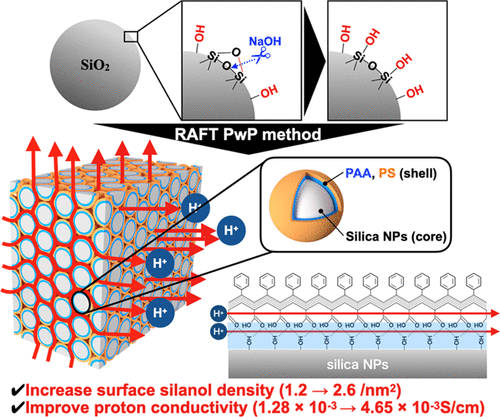当前位置:
X-MOL 学术
›
ACS Sustain. Chem. Eng.
›
论文详情
Our official English website, www.x-mol.net, welcomes your
feedback! (Note: you will need to create a separate account there.)
Effect of Surface Silanol Density on the Proton Conductivity of Polymer-Surface-Functionalized Silica Nanoparticles
ACS Sustainable Chemistry & Engineering ( IF 7.1 ) Pub Date : 2021-07-14 , DOI: 10.1021/acssuschemeng.1c01922 Kazuki Koseki 1 , Toshihiko Arita 2 , Keisuke Tabata 1 , Tomohiro Nohara 1 , Ryota Sato 1 , Shusaku Nagano 3 , Akito Masuhara 1, 4
ACS Sustainable Chemistry & Engineering ( IF 7.1 ) Pub Date : 2021-07-14 , DOI: 10.1021/acssuschemeng.1c01922 Kazuki Koseki 1 , Toshihiko Arita 2 , Keisuke Tabata 1 , Tomohiro Nohara 1 , Ryota Sato 1 , Shusaku Nagano 3 , Akito Masuhara 1, 4
Affiliation

|
We have developed a polymer electrolyte membrane (PEM) material using polymer-coated silica nanoparticles (NPs) by the reversible addition-fragmentation chain-transfer polymerization with particles (RAFT PwP) method. In this paper, we controlled the number density of surface silanol groups on the silica NPs that not only maintain the structure of the surface adsorbed polymers by RAFT PwP but also form fast proton-conducting interface to study the silanol density effect on proton conductivity. The number of surface silanol groups was successfully increased by NaOH surface treatment and decreased by heat treatment. Then, we clarified that silanol-rich silica NPs with a polyacrylic acid and polystyrene block copolymer (PAA-b-PS) applied by RAFT PwP exhibit larger proton conductivity. This result implies that hydrophilicity of the filler is one of the important factors in the design of filler-functionalized PEM with high proton conductivity.
中文翻译:

表面硅烷醇密度对聚合物表面功能化二氧化硅纳米粒子质子电导率的影响
我们通过可逆加成-断裂链转移聚合(RAFT PwP)方法开发了一种聚合物电解质膜(PEM)材料,该材料使用聚合物包覆的二氧化硅纳米粒子(NP)。在本文中,我们通过 RAFT PwP 控制二氧化硅 NPs 上表面硅烷醇基团的数量密度,不仅保持表面吸附聚合物的结构,而且形成快速质子传导界面,以研究硅烷醇密度对质子电导率的影响。NaOH 表面处理成功地增加了表面硅烷醇基团的数量,并通过热处理减少了表面硅烷醇基团的数量。然后,我们澄清了含有聚丙烯酸和聚苯乙烯嵌段共聚物 (PAA- b)的富含硅烷醇的二氧化硅 NP-PS) 应用于 RAFT PwP 表现出更大的质子传导性。该结果意味着填料的亲水性是设计具有高质子传导性的填料功能化 PEM 的重要因素之一。
更新日期:2021-08-02
中文翻译:

表面硅烷醇密度对聚合物表面功能化二氧化硅纳米粒子质子电导率的影响
我们通过可逆加成-断裂链转移聚合(RAFT PwP)方法开发了一种聚合物电解质膜(PEM)材料,该材料使用聚合物包覆的二氧化硅纳米粒子(NP)。在本文中,我们通过 RAFT PwP 控制二氧化硅 NPs 上表面硅烷醇基团的数量密度,不仅保持表面吸附聚合物的结构,而且形成快速质子传导界面,以研究硅烷醇密度对质子电导率的影响。NaOH 表面处理成功地增加了表面硅烷醇基团的数量,并通过热处理减少了表面硅烷醇基团的数量。然后,我们澄清了含有聚丙烯酸和聚苯乙烯嵌段共聚物 (PAA- b)的富含硅烷醇的二氧化硅 NP-PS) 应用于 RAFT PwP 表现出更大的质子传导性。该结果意味着填料的亲水性是设计具有高质子传导性的填料功能化 PEM 的重要因素之一。





















































 京公网安备 11010802027423号
京公网安备 11010802027423号